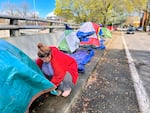
A young woman secures a tarp on her tent along SW 13th Avenue in Portland, April 4, 2022. Eight days later the camp was cleared by the city, implementing Portland Mayor Ted Wheeler's ban on camping near busy roadways.
Kristyna Wentz-Graff / OPB
After camping for years near the off ramp of the Ross Island Bridge, Gordon Muma Jr. has relocated. He now lives next to the on-ramp.
In mid March, a laminated neon green sign appeared near his camp, a notice from the city of Portland requiring him to leave his campsite. Mayor Ted Wheeler had recently banned people from setting up tents on dangerous roadways. Muma’s home of almost two years, in the middle of some grass near the west bank of the Willamette River, was one of roughly 40 campsites cleared that month as a result.
For Muma, the moving process mainly involved waiting for lulls in traffic so he could roll the 26 shopping carts filled with his belongings — bedding, clothes, mattresses, tarp tents — across the bustling roadway to his new site, roughly 350 feet away. He said he wanted to stay near the bridge, which was as removed from the downtown area as he could be while maintaining his access to the trash cans near the waterfront. He collects cans and relies on the receptacles for a trickle of income.
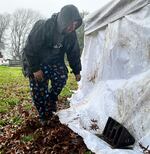
Gordon Muma Jr., moves his campsite of nearly two years near the off-ramp of the Ross Island Bridge.
Rebecca Ellis / OPB
The main difference between the locations, he said, is the cars zip by faster in the new area — they’re coming onto the bridge at up to 50 miles-an-hour instead of around a curve at half the speed.
“I don’t know why they moved me,” said Muma, a 43-year-old from Portland. “I was in no danger there. I’m in danger now.”
It’s been two months since Portland’s mayor barred people from setting up tents near busy roadways, the first in a string of emergency orders aimed at public camping. The order, and the messaging around it, was couched in humanitarian terms; Wheeler offered up the order as a common-sense response to a clearly untenable situation in which drivers sped down bustling streets, sometimes passing mere inches from people protected from the elements by a thin sheet of nylon. The mayor said this week that the order is “saving the lives of our most vulnerable neighbors.”
But while some roadways may be cleaner in the wake of the mayor’s emergency order, it’s far from clear that the people displaced are much safer. OPB visited 10 sites in the last month that were swept since the mayor’s Feb. 4 order. Despite Wheeler’s vow that people moved could not return to their old campsites, many seem to have done exactly that. Others have moved to different but equally dangerous roadways. And, some, like Muma and his friend Lenny Ronk, have shifted mere feet.
To the two men, who have been camping in the area for the better part of a decade, the mayor’s announcement is the latest example of the city picking at the most obvious symptoms of a massive, complicated crisis, shuffling people living outdoors “like a deck of cards” without providing the housing to keep them out of the game entirely.
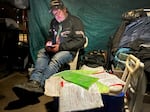
Lenny Ronk, 50, has a job but hasn't been able to save for a down payment on an apartment. He says he's been swept more than two dozen times in five years and keeps a collection of postings in his years outside.
Rebecca Ellis / OPB
Ronk, 50, lives on a median near Muma. He has a job as a mechanic, but says with a monthly $1,000 child support payment, he can’t save up for a down payment on an apartment. Local government has been little help, he says. By his count, he’s been swept more than two dozen times in five years. His tools were taken during the most recent one.
“I move, bounce back and forth across the street, back and forth for a long time,” Ronk said. “I play their game, but it’s kind of ridiculous.”
In his tent, Ronk keeps a collection of all the orders to move he’s received since he began living outside. It includes seven from a nine-month span in 2019.
Roadside dangers
As the city’s homeless crisis has spiraled out of control, another crisis has bloomed within it: a record number of people living side-by-side with speeding cars.
But while city and state leaders are more or less in consensus that people should not be camping near crowded, dangerous roadways, they remain divided on how to get there in a way that doesn’t make life worse for the people experiencing homelessness.

Camps on Southwest 13th Avenue are cleared on April 12, 2022. For over a year, the camp has been home to a group between the ages of 18 and 24, many of whom use services at at a non-profit across the street.
Rebecca Ellis / OPB
Disbanding the camps by removing people and their property or so-called “sweeping” is one tactic. Staff at the Oregon Department of Transportation began advocating for this approach during the pandemic. They had grown frustrated by the sheer number of tents cropping up on state property after the city of Portland cut back on sweeps to prevent the spread of COVID-19.
Under a 2018 agreement, the state transportation agency pays the city of Portland every year to clear the garbage and homeless camps on state property inside the metro area. By the end of 2021, ODOT staff felt the city was no longer holding up its end of the bargain, according to emails obtained through a public records request.
In December 2021, Rian Windsheimer, ODOT’s point person for the Portland region, wrote Wheeler aide Sam Adams asking the city to “significantly ramp up operations” on ODOT-owned roadways. Windsheimer cited several recent deaths of people experiencing homelessness killed on state land. Windsheimer followed up again in January to request a meeting.
“The City is not meeting ODOT expectations and we need to see immediate changes,” Windsheimer wrote Adams.
On Feb. 2, the Portland Bureau of Transportation released a report suggesting the situation was more dangerous that many had grasped. The report found people experiencing homelessness made up an overwhelming number of pedestrian deaths in Portland last year. Seventy percent of pedestrians — 19 out of 27— killed by cars in 2021 were living outdoors when they died.
Two days after that report was published, Wheeler announced he would use his mayoral powers to bar people from setting up tents on 30 high-crash roadways across the city. Campers who returned would be forced to leave under a “no right of return” policy, he said. He acknowledged the plan had been in the works before the report, but framed his order as a logical follow up to the startling numbers.
“We have continuously witnessed unsanctioned camping in clearly unsafe locations, sometimes jarringly close to roads and freeways,” Wheeler said at the time. “You don’t need to be a traffic engineer to sense that that’s not safe.”
‘We are all blindsided’
But in a city where there are nowhere near enough shelter beds nor homes for everyone on the street, homeless advocates were skeptical that people displaced during sweeps would be any safer. So were the transportation experts.
“I’m not even sure I understand what it means and it’s certainly not a policy choice that makes sense to us in traffic safety,” one Portland Bureau of Transportation manager wrote to staff with the city’s Urban Camping Impact Reduction Program after learning of the mayor’s order, according to emails obtained through a record request. “I’m trying to understand how this came to be.”
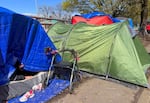
A walker is decorated with flowers, parked outside of a tent along Southwest 13th Avenue, in Portland, April 4, 2022.
Kristyna Wentz-Graff / OPB
A spokesperson for the city’s transportation bureau said the department was not consulted by the mayor’s office on the executive order. At the time, transportation bureau staff had been mulling their own approach to address the rise of people killed on the streets, according to emails. A month before the mayor’s order, staff considered handing out reflective items that campers could put on their coats and a small laminated card with fatality statistics and information on high-risk areas that outreach workers could give campers. None of these proposals were mentioned in the mayor’s announcement.
“Our mayor took another tactic and used the report to justify an emergency order to sweep camps along interstates and high crash corridors,” a transportation bureau coordinator wrote to the director of the Vision Zero Network. “We are all blindsided and feeling devastated by this.”
Transportation bureau spokesperson Dylan Rivera said the city agency is still working on crafting an informational card for campers. He added that the bureau has spearheaded several initiatives in recent years to help make people experiencing homelessness more visible to drivers, including distributing safety vests, neon green hats, reflective stickers and yellow rain jackets.
In the wake of the mayor’s order, transportation advocates quickly accused him of using the report on roadside deaths as a justification for more sweeps rather than to push a bona fide safety effort. Scott Kocher, an advocate for safer streets and board member of Oregon Walks, said he believes there are more practical steps the mayor could have taken if he was focused purely on reducing deaths, such as lowering speed limits on the streets where the city routinely sees traffic fatalities. He said he would be surprised if the mayor’s emergency order leads to any long-term improvement in safety statistics.
“There’s a bigger crisis here; don’t get me wrong,” Kocher said. “But there are some very specific things that the city needs to be doing to provide safety for our most vulnerable people.”
The bigger crisis, of course, is that many people camping on these bustling roadways have nowhere to go. Some city leaders say this means people displaced from one dangerous area will simply migrate to a different one.
“Do I think it’s going to fix the problem? No,” Commissioner Jo Ann Hardesty, who oversees the city’s transportation bureau, said during a recent interview related to her reelection campaign. “All we’re doing is sweeping the problem from one place to another place if we’re not dealing with the fundamental issue, which is where can people safely be able to rest when they don’t have a permanent place to call home?”
Wheeler acknowledged the lack of shelter beds available when he announced the roadside camping ban. He told reporters he had just asked Gov. Kate Brown to help the city add an additional 1,000 shelter beds.
That substantial increase has not yet happened, though Denis Theriault, a spokesperson for the Joint Office of Homeless Services, said the city and county have been steadily ramping up the number of shelter beds over the last year. Theriault said there will be close to 2,100 beds available once a new shelter on Southeast Market Street opens and shelters that spaced out their beds during the pandemic stop social distancing. That’s up from 1,350 beds a year ago. Property owners nearby recently sued to stop the Southeast Market shelter from opening.
Still, available bed space pales in comparison to the need, even with the additions. There were roughly 4,000 people experiencing homelessness in the region at the last official count in 2019, and experts predict that number has likely grown dramatically in the years since.
The cycle continues
Staff in the mayor’s office said they believe the emergency order has so far been successful. City crews have removed over 70 camps throughout Portland and referred 42 people to shelter, they said. About six camps were swept more than once and all but a handful were considered to pose a significant enough health and safety risk that they may have been swept even without the emergency declaration, according to statistics provided by the mayor’s office.

Following the sweet of a camp on Southwest 13th Avenue in Portland, people search for a new camp location, April 12, 2022.
Rebecca Ellis / OPB
“When I signed the emergency declaration on February 4th of this year, I said that we must do everything we can to move unsheltered Oregonians away from dangerous roadways,” Wheeler said in a written statement. “Just over two weeks ago, there was a tragic event in Salem, Oregon where a driver crashed into a homeless camp, taking the lives of four unsheltered Oregonians. I am working to prevent similar incidents from happening in Portland.”
Since the mayor’s order, two more people experiencing homelessness have been killed by cars, both by hit-and-run drivers. On March 3, the police bureau said a 46 year-old-man was killed on Southeast 66th Avenue and Division Street. A woman was killed on Southeast 47th and Powell Boulevard on April 4. Both are considered “high-crash” streets.
ODOT manager Windsheimer said these deaths, in addition to the recent deaths in Salem, underscore the safety issues that arise when camps are left untouched.
OPB asked ODOT if they felt the mayor’s order had addressed the agency’s concerns. They responded with the following statement:
“Yes, the Mayor’s declaration has been helpful in both calling attention to the serious safety issues that camps along roadways presents and in focusing the City’s crews to address them,” Windsheimer said in an emailed statement. “Allowing camps along high-speed facilities to remain in place is dangerous to campers and the traveling public. I think ODOT and the City would agree that more can and should be done to find safer places for homeless people to stay.”
In the meantime, the camp removals along busy roads continue as city crews work their way north on Interstate 405.

Camps on Southwest 13th Avenue are cleared from the area on April 12, 2022.
Rebecca Ellis / OPB
On Tuesday morning, a chaotic scene unfolded on the corner of Southwest 12th Avenue and Main Street, as a group of about a dozen or so people stood in a drizzle debating where to go. Their camp one block to the east, perched just above the I-405, was in the process of being dismantled.
Jerry Adams, who said he had been living at the camp on and off for three years, considered moving the group down the block, but suspected the owner of an Indian restaurant on the corner would complain. He was less sure about whoever owned the old Brazilian Grill in the middle of the block. Their current corner was a no-go. As the campers stood strategizing with their possessions scattered around them in carts and duffel bags, a security guard approached and said they were too close to Northwest Academy, a middle school on the street.
For over a year, the camp has been home to a group between the ages of 18 and 24. Many use the services across the street at Outside In, a nonprofit that offers them showers, laundry and occasional medical appointments.
Heather Hafer, a city spokesperson, said the camp had been on the city’s radar for several months, but became a priority due to the mayor’s emergency order and an escalating “health and safety score.”
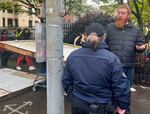
Jerry Adams tries to find a new place for the campers, April 12, 2022, after the city removed their Portland camp a block away as part of the mayor’s ban on camping near busy roadways.
Rebecca Ellis / OPB
Samantha Lingo, 24, said she needed Outside In for prenatal care. She said she’s four months pregnant and worried what the stress surrounding the sweep was doing to her unborn child.
Lingo said she understood why city leaders didn’t want her and other campers so close to the highway, particularly when there weren’t sufficient guardrails. She said she’d had friends killed recently in a car accident in the area. But she didn’t see many alternatives while she waited for housing to open up.
“It’s a better idea to be somewhere else, but they don’t really give us a lot of options of where we’re supposed to go,” she said.
Within two hours, the bulk of the campers on the corner were pitching tents one block away, feet from a parking lot.
By 3:30, another neon green posting appeared on the block. The campers had three days to find a new spot.
